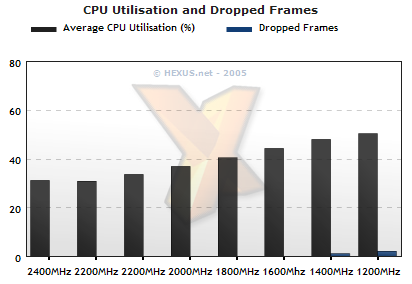Video Quality and Performance
Tuner quality and performance was tested under Windows XP Media Center Edition on an Athlon 64 4000+ system using an ATI Theater 550 PRO tuner and my TV's own tuner as comparison. MCE doesn't support mixing analogue and digital tuners (as far as I'm aware), so digital TV quality was compared to my own Daewoo DS700 DVB-T set-top receiver with the 550 PRO removed.Output video was captured both to disk using MCE's capture support, and output via SCART on the AIW to my DVD recorder deck. The deck was set to no video compression, recording the TV as a maximum quality MPEG-2 AV stream so as not to introduce its own video compression artifacts into that which was output from the respective tuners.
Video quality was measured using the same tests I used in our last AIW article, here. Video was fed in to the hardware via my DVD deck as two separate uncompressed MPEG-2 streams that the hardware was then asked to clean up.
Video performance was analysed by setting MCE's quality settings to produce most CPU load, then an approach of reducing CPU frequency 200MHz at a time (one multiplier step each time) to find where the CPU was becoming the bottleneck, rather than the processing being done by the tuner hardware. Both Theater 550 PRO and the Theater 200 on the AIW are able to process MPEG-2 from tuned TV in real-time.
Tuner Quality
In the absence of a same-frame capture system (we're working on it), tuner quality is subjective. I've experienced a ton of analogue tuners in my time and I'm partial to the quality provided by Microtune's silicon tuners, after further processing by ATI's Theater hardware. I'm not sure what the MT2121 changes in terms of analogue tuning compared to the MT2050 used on the AGP All-In-Wonder we reviewed back in March, or the tuner used by standalone PCI Theater 550 PRO-based cards, but, and this might well be due to slight differences in signal quality from my splitter setup I use to feed the tuners for this part of testing, I prefer the output of the MT2121 over the tuner on my TV, the MT2050 on the Theater 550 PRO-based tuner and the same MT2050 on the older AGP All-In-Wonder.For digital quality, the tuner in my Daewoo DS700 matches what the MT2121 can do. The strong signal I receive due to being 200m from the DVB-T transmitter from my area means that my DVB-T tuners often have too much signal to cope with and a filter needs to be applied to reduce signal strength. Using the same filtered signal, there's no difference between the two. Freeview in the UK means fairly heavily compressed MPEG-2 AV, but that seems to be handled well by my cheap old Daewoo just as well as untouched output from the All-In-Wonder.
However, the filters available in VideoSoap help with the deblocking that accompanies compressed high-motion MPEG-2, so with those applied the All-In-Wonder is the best TV tuner in my posession. I can't say more than that.
Please forgive us for not offering you same-frame output to compare all the tuners tested. We're still making the investment in the hardware and software needed for us to be able to do that. We're confident our subjective opinion stands up, the MT2121-equipped AIW doing as well with DVB-T as many other set-top boxes (helped by the fact all the video is in the digital domain). A nice test would have been to test a weaker signal, to see how the tuners cleaned up. It's more about error correction than filtering, since it's a digital MPEG-2 video stream. The NXT6000 is responsible for that on these new AIW boards, ATI confident it does a nice job.
For examples of the tuner quality the All-In-Wonder X800 GT has, tuning DVB-T, click the following images. Note the good deinterlacing and lack of compression artifacts (especially around the TMF logo, where it'd be ripe for abuse). 720x576 video like that looks great on my TV, via the AIW.
For analogue quality shots, click here and here. Tuner quality is much more grained than the DVB-T tuning, but comparative to the other tested analogue tuners, the output quality from the All-In-Wonder X800 GT is good. Even with the Theater 550 PRO to clean the video up with its extra decomb filters, the AIW does a better job at PAL tuning in my eyes.
Video Quality
Working with uncompressed MPEG-2 video, the new AIW is no better than the old which is expected given that they both use the same video processor in Theater 200. Our comments from the last AIW review stand up as correct here too.Subjective quality was tested using two maximum bitrate MPEG-2 streams, one low-motion, one high-motion, compared to the same test video played back through an ATI Theater 550 PRO PCI tuner and also captured to MPEG-2. At maximum bitrates for each, but scaled output (I 'drop' around 10% of the scanlines in the scaler), there's little to choose between the two output engines (we're comparing Theater 200 to Theater 550 PRO in terms of MPEG-2 output here) when I feed them PAL DVD video streams via the composite connector. This test basically does passthrough of the video stream, after cleanup and scaling.
The Theater 550 PRO offers better output quality for the low-motion video, due to its more advanced comb filter (per-pixel 3D comb). With the high-motion video there's similar levels of aliasing and artifacting with both, indicating the 550 PRO is selecting 2D comb for most of the frame. In this respect, although subjective, the 200 does well against its newer and technically advanced sibling.
Video Performance
Video performance was tested slightly differently than in the past. With the low CPU utilisation of the Athlon 64 4000+ (FX-53) last time, I wanted to see how low you can go on the CPU and still maintain a usable system. I set up MCE to record television (simulated using a composite feed from the DVD deck) to hard disk using the AIW X800 GT. Average CPU utilisation (and the highest spike) was measured over the 10 minute capture period at all the CPU frequencies. Frames dropped were also measured.
CPU utilisation is low throughout when recording to disk, dropped frames are minimal (2 frames over 10 minutes at 1200MHz is a fraction of one percent of the 15000 or so total frames). Performance has always been decent when recording WMV9 as seen in MCE, using ATI hardware and a decent CPU.











